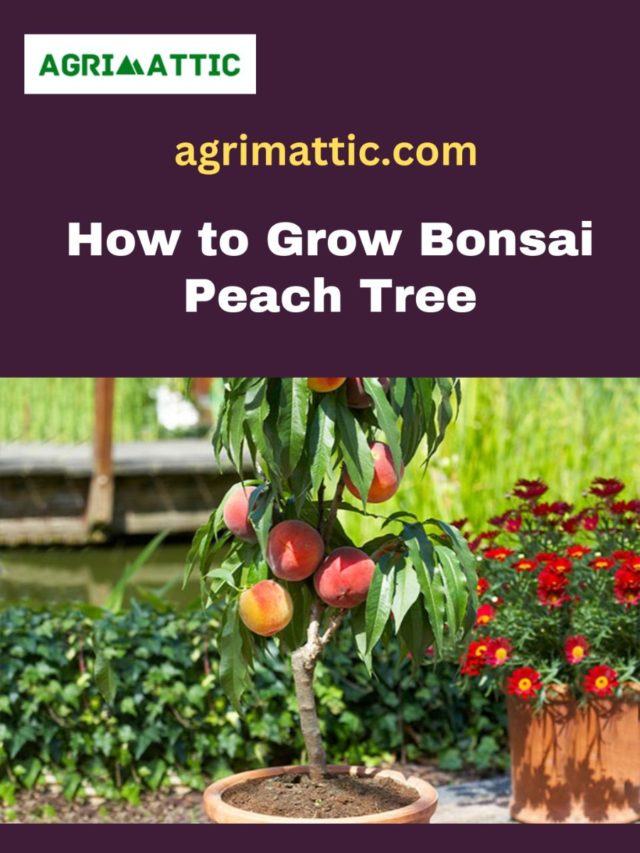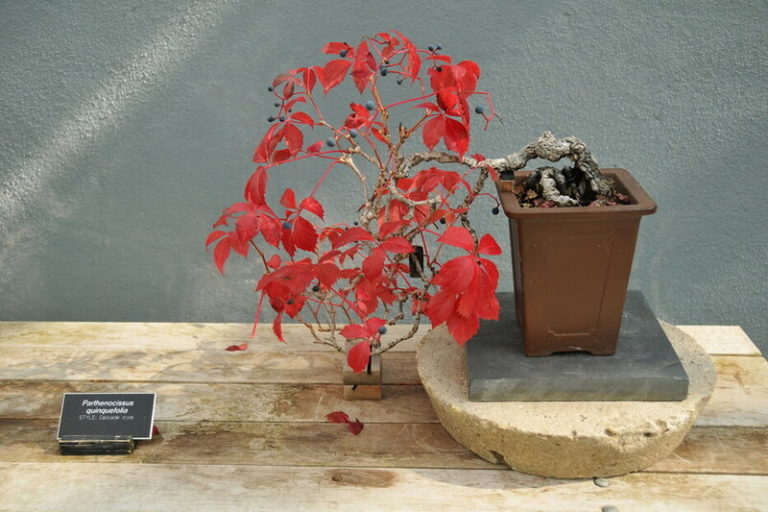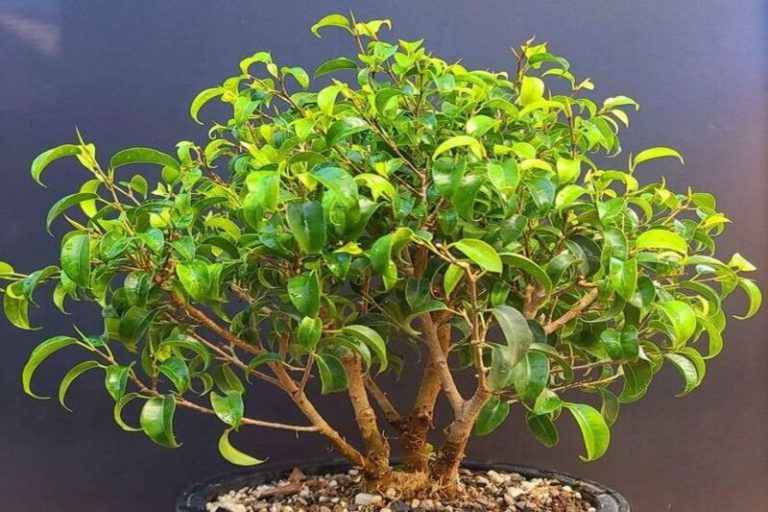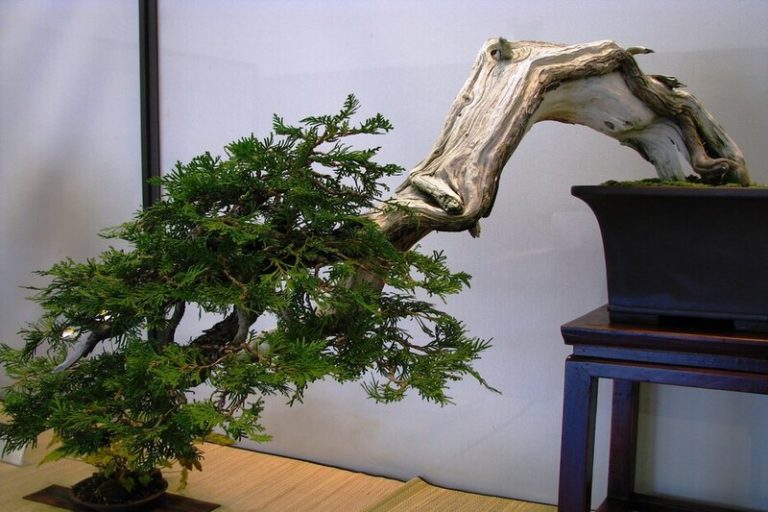Bonsai Peach Tree : A Miniature Tree with Maximum Charm
Bonsai trees are a popular hobby among people who love gardening and plants. One of the most popular types of bonsai trees is the bonsai peach tree. These trees are miniature versions of the full-sized peach trees that bear fruit. They are grown in small pots and are carefully shaped and pruned to maintain their small size.
What is Bonsai Peach Tree?
A Bonsai Peach Tree is a miniature version of a regular peach tree that is grown using the art of bonsai. Bonsai is the practice of growing small trees in pots and shaping them through pruning and wiring to create a miniature version of the tree. Bonsai Peach Trees are grown in small pots and are carefully pruned and shaped to maintain their small size. They produce lovely pink or white flowers in the spring and small peaches
Types of Bonsai Peach Tree
There are several types of Bonsai Peach Trees that are commonly grown, each with its own unique characteristics. Here are a few of the most popular types:
Red Haven Peach Tree – This is a popular choice for Bonsai Peach Trees because of its medium size and hardiness. It produces bright red peaches in the summer.
Dwarf Bonfire Peach Tree – This variety is known for its small size and attractive red foliage, making it a popular choice for Bonsai cultivation. It produces small, flavorful peaches in the summer.
Golden Glory Peach Tree – This variety is known for its yellow-orange fruit and attractive foliage. It is a good choice for those who prefer a larger Bonsai Peach Tree.
White Lady Peach Tree – This is a smaller variety that produces white peaches. It is a good choice for those who want a smaller Bonsai Peach Tree that is easier to maintain.
Elberta Peach Tree – This is a larger variety that produces large, juicy peaches. It is a good choice for those who want a larger Bonsai Peach Tree that can produce fruit.
There are many other varieties of Bonsai Peach Trees available, each with its own unique characteristics. It is important to choose a variety that is well-suited to your climate and growing conditions and that will be easy to maintain as a Bonsai tree.
Bonsai Peach Trees and Its Symbolism
Bonsai Peach Trees have a rich history of symbolism in many cultures. In Japan, Bonsai trees are believed to represent harmony, balance, and the natural world. In Chinese culture, peach trees symbolize longevity and good fortune, and are often used in traditional Chinese medicine.
In the art of Bonsai, the process of shaping and pruning the tree is seen as a way to create a sense of balance and harmony between the tree and its surroundings. The miniature size of the Bonsai Peach Tree also symbolizes the idea of a small universe in which everything is connected and in harmony.
In addition to their cultural symbolism, Bonsai Peach Trees also have personal meanings for many people. They are often given as gifts to symbolize friendship, good luck, or personal growth. The process of caring for a Bonsai Peach Tree can also be seen as a way to cultivate patience, discipline, and mindfulness.
Overall, the symbolism of Bonsai Peach Trees is complex and multifaceted. They are a powerful symbol of nature, harmony, and personal growth, and have been treasured by many cultures for centuries.
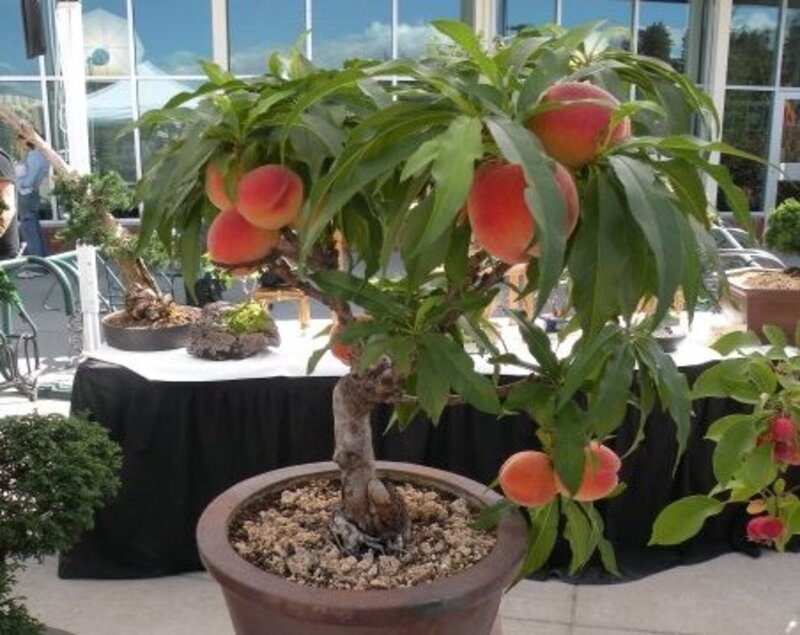
Characteristics of Bonsai Peach Tree
Bonsai Peach Trees have unique characteristics that make them distinct from regular peach trees. Here are a few of the main characteristics of Bonsai Peach Trees:
- Small size: Bonsai Peach Trees are miniature versions of regular peach trees and are grown in small pots. They typically range in height from 6 inches to 2 feet, depending on the variety and how they are pruned.
- Attractive foliage: Bonsai Peach Trees have attractive green leaves that are often glossy and shiny. Some varieties also have red or yellow foliage that adds to their aesthetic appeal.
- Beautiful flowers: Bonsai Peach Trees produce lovely pink or white flowers in the spring that are a delight to behold. The flowers have a sweet fragrance that fills the air.
- Fruit production: While Bonsai Peach Trees are not typically grown for their fruit, they can produce small peaches in the summer. These peaches are usually smaller than regular peaches, but are still edible and flavorful.
- Care requirements: Bonsai Peach Trees require regular care and maintenance to stay healthy and attractive. This includes regular pruning and shaping, fertilization, and watering.
Overall, Bonsai Peach Trees are prized for their unique beauty and for the challenge of growing and shaping them into miniature works of art. With proper care and attention, they can be enjoyed for many years as a beautiful addition to any home or garden.
How to Grow Bonsai Peach Tree
Growing a Bonsai Peach Tree requires some patience, skill, and attention to detail. Here are the basic steps for growing a Bonsai Peach Tree:
1. Choose the right variety: Select a peach tree variety that is suitable for Bonsai cultivation. Some good options include ‘Bonfire’ and ‘Red Haven’ peach trees.
2. Start with a young tree: Purchase a young peach tree that is at least one year old and has a sturdy trunk. Make sure the roots are healthy and well-developed.
3. Choose a suitable pot: Bonsai Peach Trees should be grown in a shallow pot with good drainage. Choose a pot that is slightly larger than the tree’s root ball.
4. Plant the tree: Plant the peach tree in the pot using well-draining soil that is rich in nutrients. Make sure the soil is moist but not waterlogged.
5. Prune and shape the tree: Regularly prune the tree to maintain its shape and promote healthy growth. Remove any dead or diseased branches, and trim back new growth as needed.
6. Fertilize the tree: Bonsai Peach Trees require regular fertilization to stay healthy and produce fruit. Use a balanced fertilizer that is specifically designed for Bonsai trees.
7. Water the tree: Water the peach tree regularly, making sure to keep the soil moist but not waterlogged. Allow the soil to dry out slightly between watering.
8. Provide sunlight: Bonsai Peach Trees require plenty of sunlight to grow and thrive. Place the tree in a sunny location that receives at least 6 hours of direct sunlight per day.
Growing a Bonsai Peach Tree can be a rewarding and enjoyable experience. With proper care and attention, your tree can thrive and produce beautiful flowers and fruit for years to come.
Benefit of Bonsai Peach Trees
Bonsai Peach Trees have a range of benefits that make them a popular choice for many gardeners and plant enthusiasts. Here are a few of the main benefits of Bonsai Peach Trees:
- Aesthetics: Bonsai Peach Trees are a beautiful addition to any home or garden. They add visual interest and beauty with their lovely foliage and delicate flowers.
- Personal growth: Growing and caring for a Bonsai Peach Tree requires patience, discipline, and attention to detail. This process can be a great way to cultivate personal growth and mindfulness.
- Fruit production: While Bonsai Peach Trees are not typically grown for their fruit, they can produce small peaches in the summer. These peaches are usually smaller than regular peaches, but are still edible and flavorful.
- Air purifying: Like all plants, Bonsai Peach Trees help to purify the air by removing pollutants and producing oxygen.
- Stress relief: Many people find gardening and caring for plants to be a relaxing and stress-relieving activity. Bonsai Peach Trees can be a great way to reduce stress and promote a sense of calm and wellbeing.
Overall, Bonsai Peach Trees are a beautiful and rewarding plant to grow. They offer a range of benefits for both physical and mental health, and can provide a sense of joy and satisfaction for years to come.
Styling and Design of Bonsai Peach Trees
The styling and design of Bonsai Peach Trees can vary depending on the personal preferences of the grower, but there are a few common styles and techniques that are often used. Here are some popular styling and design options for Bonsai Peach Trees:
Informal upright style: This style involves a tree with a slightly curved trunk that grows upright. The branches are arranged in an irregular, natural-looking pattern.
Cascade style: In this style, the tree is trained to grow downward in a cascading fashion. The branches are arranged in a layered pattern to create a sense of depth and movement.
Formal upright style: This style involves a straight, upright trunk with branches arranged in a symmetrical pattern. The tree is often shaped to resemble a miniature version of a full-grown peach tree.
Windswept style: This style involves a tree that appears to have been shaped by strong winds. The trunk is slanted to one side, and the branches are arranged in a sweeping pattern.
Multi-trunk style: In this style, the tree is grown with multiple trunks that grow from a single root system. The trunks are arranged in an interesting, visually appealing pattern.
When designing and styling a Bonsai Peach Tree, it’s important to consider the natural growth patterns of the tree and work with them to create a visually appealing design. With careful pruning and training, it’s possible to create a stunning, unique Bonsai Peach Tree that is a true work of art.
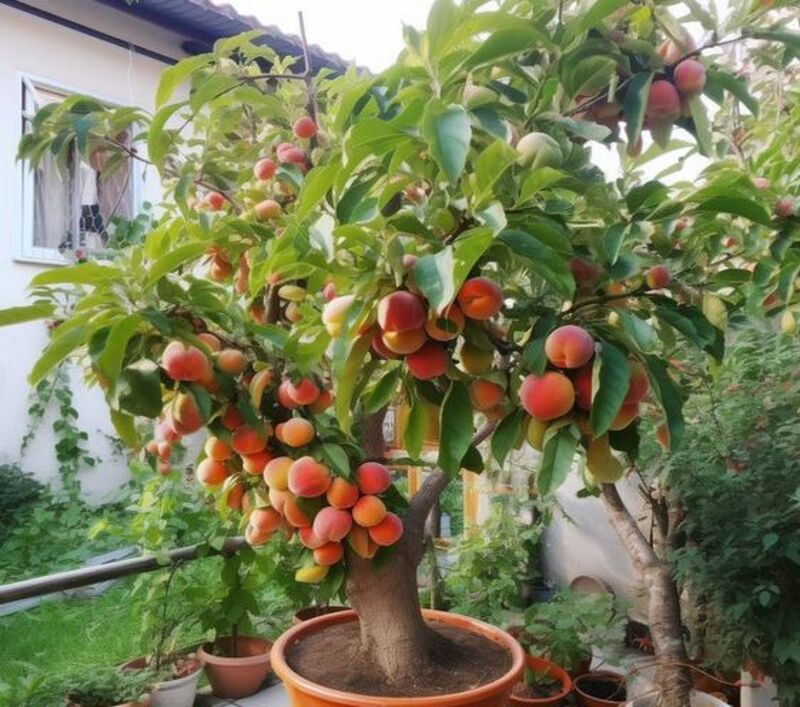
How to Care and Maintain Bonsai Peach Trees
Caring for and maintaining a Bonsai Peach Tree requires attention to detail and regular care. Here are some tips to help you keep your Bonsai Peach Tree healthy and thriving:
- Watering: Bonsai Peach Trees require regular watering, but it’s important not to overwater them. Water the tree deeply, making sure the soil is moist but not waterlogged. Check the soil regularly to ensure it’s not too dry or too wet.
- Fertilizing: Bonsai Peach Trees benefit from regular fertilization to promote healthy growth. Use a balanced fertilizer during the growing season (spring and summer), and reduce or stop fertilization during the winter.
- Pruning: Regular pruning is essential to maintain the shape and size of the tree. Prune back new growth in the spring and summer, and remove any dead or damaged branches.
- Repotting: Bonsai Peach Trees should be repotted every 2-3 years to provide fresh soil and encourage healthy growth. Repot in the spring, using a well-draining soil mix.
- Sunlight: Bonsai Peach Trees require plenty of sunlight to thrive. Place your tree in a location that receives at least 6 hours of direct sunlight per day.
- Pest and disease control: Keep an eye out for pests and diseases, and treat them promptly to prevent them from spreading to the rest of the tree. Common pests include aphids, spider mites, and scale insects.
- Winter care: Bonsai Peach Trees require protection from freezing temperatures during the winter. Move your tree indoors or cover it with a protective layer of mulch or burlap to prevent damage.
By following these tips and providing your Bonsai Peach Tree with the proper care and maintenance, you can help ensure that it remains healthy and beautiful for years to come.
Bonsai Peach Tree Care Sheet
| Aspect | Care Tips |
| Watering | Water deeply, making sure soil is moist but not waterlogged. Check soil regularly. |
| Fertilizing | Use balanced fertilizer during growing season, reduce or stop during winter. |
| Pruning | Prune back new growth in spring and summer, remove dead or damaged branches. |
| Repotting | Repot every 2-3 years in spring, use well-draining soil mix. |
| Sunlight | Place in location that receives at least 6 hours of direct sunlight per day. |
| Pest and disease control | Watch for pests and diseases, treat promptly to prevent spreading. Common pests include aphids, spider mites, and scale insects. |
| Winter care | Protect from freezing temperatures during winter. Move indoors or cover with mulch or burlap. |
By following this care sheet, you can help ensure that your Bonsai Peach Tree remains healthy and beautiful for years to come.
Conclusion
Growing a bonsai peach tree is a rewarding and enjoyable hobby. It offers many benefits, such as a beautiful addition to your garden or home, educational opportunities, and potential health benefits. With the right care and maintenance, a bonsai peach tree can be a joy to grow and admire for years to come.
FAQ:
Q: What is a Bonsai Peach Tree?
A: A Bonsai Peach Tree is a miniature tree that is grown and trained to mimic the shape and appearance of a full-sized peach tree.
Q: Can Bonsai Peach Trees bear fruit?
A: Yes, but it may take several years of careful care and training.
Q: How often should I water my Bonsai Peach Tree?
A: Water deeply, check soil regularly, avoid waterlogging.
Q: When should I fertilize my Bonsai Peach Tree?
A: During the growing season, use balanced fertilizer, reduce or stop in winter.
Q: How often should I prune my Bonsai Peach Tree?
A: Prune back new growth in spring and summer, remove dead or damaged branches.
Q: How often should I repot my Bonsai Peach Tree?
A: Every 2-3 years in the spring with a well-draining soil mix.
Q: Can Bonsai Peach Trees be kept indoors?
A: Yes, but they need at least 6 hours of direct sunlight per day and protection from freezing temperatures during winter.
Also Read:


